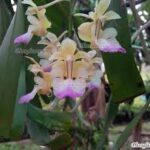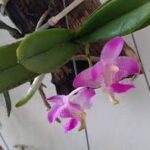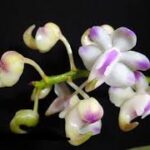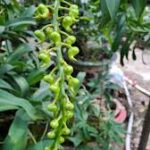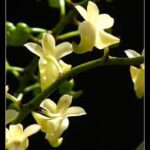
Sato Cymbidium orchids are renowned for their exquisite blooms and rich colors, making them a favorite among orchid enthusiasts and florists alike. These orchids, with their elegant flowers and graceful appearance, can bloom multiple times a year under the right conditions. This article will explore the secrets to ensuring that your Sato Cymbidium orchids not only thrive but also produce abundant blooms throughout the year. We will cover essential aspects such as light, temperature, humidity, fertilization, and care techniques that contribute to the success of these beautiful plants.
## 1. Understanding the Growth Cycle of Sato Cymbidium Orchids
Before diving into the care tips, it’s essential to understand the growth cycle of Sato Cymbidium orchids. These orchids typically have a biennial growth pattern, meaning they can produce blooms once or twice a year, depending on their growing conditions. The following stages characterize their growth cycle:
### 1.1 Vegetative Growth
During the vegetative growth stage, the plant focuses on producing healthy leaves and roots. This stage typically occurs in spring and summer when the days are longer, and the light intensity is higher. Providing adequate light and nutrients during this time is crucial for building a robust foundation for future blooms.
### 1.2 Flowering Stage
As the temperatures start to cool in late summer or early fall, Sato Cymbidium orchids begin to prepare for their flowering stage. The plant needs specific environmental cues, including reduced light, lower temperatures, and proper care, to trigger blooming. Understanding this transition is vital for achieving multiple blooms.
### 1.3 Dormancy
After blooming, Sato Cymbidium orchids enter a period of dormancy, typically in winter. During this time, the plant conserves energy and prepares for the next growth cycle. Proper care during dormancy is essential for ensuring the plant’s health and readiness for future blooms.
## 2. Optimal Light Conditions
Light is one of the most critical factors affecting the blooming of Sato Cymbidium orchids. Understanding how to provide the right light conditions will help ensure that your orchids bloom multiple times a year.
### 2.1 Light Requirements
Sato Cymbidium orchids thrive in bright, indirect light. Here are some key points to consider:
– **Optimal Light Intensity**: Ideally, your orchids should receive 1,500 to 3,000 foot-candles of bright, indirect light. This intensity promotes healthy foliage and encourages blooming.
– **Use of Natural Light**: Placing your orchids near east or west-facing windows can provide ample natural light. If your windows do not allow sufficient light, consider using sheer curtains to diffuse the light and prevent leaf burn.
– **Supplement with Artificial Lighting**: If natural light is inadequate, especially during winter months, consider using grow lights. Full-spectrum LED lights are a great option, as they provide the necessary wavelengths for photosynthesis and can be adjusted to mimic natural daylight.
### 2.2 Managing Light Exposure
Managing light exposure is crucial for inducing blooming in Sato Cymbidium orchids. Here are some tips:
– **Monitor Light Levels**: Regularly check the light levels using a light meter to ensure your orchids receive the appropriate intensity.
– **Adjusting for Seasons**: As daylight hours change with the seasons, be ready to adjust your light setup. During shorter days in winter, supplement natural light with artificial sources to maintain consistent growth.
## 3. Temperature Control
Temperature plays a significant role in the blooming process of Sato Cymbidium orchids. Maintaining the right temperature range is essential for encouraging multiple blooms throughout the year.
### 3.1 Ideal Temperature Range
– **Daytime Temperature**: Sato Cymbidium orchids prefer daytime temperatures between 70°F and 80°F (21°C to 27°C). This range encourages healthy growth and flowering.
– **Nighttime Temperature**: A drop in temperature at night is crucial for triggering blooming. Nighttime temperatures should be between 55°F and 65°F (13°C to 18°C). The temperature difference between day and night helps stimulate flower development.
### 3.2 Seasonal Temperature Adjustments
During the transition between seasons, it’s essential to adjust your temperature settings:
– **Cooling for Flower Induction**: As fall approaches, gradually lower the nighttime temperature to encourage flower induction. This change signals the plant to prepare for blooming.
– **Avoiding Sudden Temperature Fluctuations**: Sudden changes in temperature can stress your orchids and disrupt their growth cycle. Ensure a gradual transition to maintain their health.
## 4. Humidity Levels
Humidity is another critical factor that influences the blooming of Sato Cymbidium orchids. Orchids thrive in environments with higher humidity levels, which help support their growth and flowering potential.
### 4.1 Ideal Humidity Range
– **Optimal Humidity Levels**: Sato Cymbidium orchids thrive in humidity levels between 50% and 70%. Maintaining this range helps keep the plant hydrated and promotes blooming.
### 4.2 Increasing Humidity
Here are some methods to increase humidity levels around your orchids:
– **Using Humidifiers**: Placing a humidifier near your orchids can help maintain consistent humidity levels, especially in dry indoor environments.
– **Misting**: Lightly misting your orchids with water can temporarily increase humidity. However, avoid excessive misting, as it can lead to fungal issues.
– **Pebble Trays**: Setting your pots on trays filled with pebbles and water can create a microenvironment with increased humidity around the plants.
## 5. Fertilization Techniques
Proper fertilization is essential for promoting healthy growth and multiple blooms in Sato Cymbidium orchids. Understanding when and how to fertilize can make a significant difference in bloom production.
### 5.1 Choosing the Right Fertilizer
– **Balanced Fertilizer**: Use a balanced orchid fertilizer with an N-P-K ratio of 30-10-10 or similar. This high nitrogen formula promotes foliage growth, which is crucial for supporting blooms.
– **Specialized Bloom Boosters**: During the blooming stage, consider switching to a bloom booster fertilizer that has higher phosphorus content (the middle number in the N-P-K ratio). This fertilizer encourages flowering and can enhance bloom quality.
### 5.2 Fertilization Schedule
– **Regular Feeding**: During the active growth phase (spring and summer), fertilize your Sato Cymbidium orchids every 2 to 4 weeks. Dilute the fertilizer to half the recommended strength to prevent over-fertilization.
– **Reducing Feeding During Dormancy**: In fall and winter, reduce fertilization to once every 4 to 6 weeks or stop altogether during the dormant period. This approach allows the plant to conserve energy and prepare for the next growth cycle.
## 6. Pruning and Grooming
Regular pruning and grooming of your Sato Cymbidium orchids can encourage healthy growth and multiple blooms.
### 6.1 Removing Dead or Yellow Leaves
– **Regular Inspections**: Periodically check your orchids for any dead or yellowing leaves. Removing these leaves will improve air circulation and allow the plant to focus its energy on new growth and blooms.
### 6.2 Cutting Flower Spikes
– **Post-Bloom Care**: After the blooms have faded, consider cutting the flower spikes back to the base. This encourages the plant to channel its energy into new growth and can promote additional blooming.
## 7. Repotting and Container Considerations
Repotting your Sato Cymbidium orchids at the right time can significantly impact their blooming potential.
### 7.1 When to Repot
– **Timing**: Repot your orchids every 1 to 2 years or when you notice that the potting medium has broken down. The best time to repot is during the active growth phase in spring.
### 7.2 Choosing the Right Potting Medium
– **Well-Draining Mix**: Use a well-draining potting medium specifically formulated for orchids. A mix of bark, perlite, and sphagnum moss is ideal for promoting healthy root growth and preventing water retention.
### 7.3 Container Size
– **Pot Size**: Choose a pot that allows for adequate root growth without being too large. An oversized pot can lead to water retention and root rot, which may hinder blooming.
## 8. Stress Management
While stress is generally detrimental to orchids, managing it appropriately can sometimes encourage blooming.
### 8.1 Controlled Stress Techniques
– **Gradual Changes**: Implement gradual changes to light, temperature, and humidity levels. Sudden changes can stress your orchids, while gradual adjustments help them acclimate and can stimulate blooming.
### 8.2 Mimicking Natural Conditions
– **Seasonal Cues**: Try to mimic natural seasonal cues as much as possible. Gradually lowering temperatures, reducing watering, and changing light exposure can signal your orchids to prepare for blooming.
## 9. Conclusion
Achieving multiple blooms of Sato Cymbidium orchids throughout the year requires a thorough understanding of their growth cycle and the environmental conditions that promote healthy flowering. By providing optimal light, temperature, humidity, and nutrition, you can create an ideal environment for your orchids to thrive. Regular care, including pruning and proper potting techniques, will further enhance your chances of enjoying the stunning blooms of Sato Cymbidium orchids multiple times a year.
With dedication and attention to detail, you can unlock the secrets to successful orchid cultivation and witness the beauty of these remarkable flowers gracing your home or garden throughout the seasons. Embrace the journey of caring for your Sato Cymbidium orchids, and you’ll be rewarded with a vibrant display of blooms that will surely captivate anyone who lays eyes on them.
# Secrets to Achieving Multiple Blooms of Sato Cymbidium Orchids Throughout the Year (Part 2)
In the first part of this guide, we delved into the fundamental aspects of caring for Sato Cymbidium orchids to encourage them to bloom multiple times throughout the year. This second part will expand on advanced techniques, seasonal care adjustments, pest management, and additional tips to ensure your Sato Cymbidium orchids thrive and bloom abundantly. Let’s explore how to maximize the blooming potential of these beautiful orchids.
## 1. Seasonal Care Adjustments
To encourage multiple blooms, it’s essential to adjust care techniques according to the changing seasons. Each season presents unique challenges and opportunities for your Sato Cymbidium orchids.
### 1.1 Spring Care: Encouraging Growth and Flowering
As spring arrives, your orchids enter a period of active growth. This is the ideal time to focus on promoting healthy foliage and setting the stage for blooms.
– **Increase Watering**: As the temperatures rise, increase the frequency of watering to keep the potting medium consistently moist. Be careful not to overwater, as this can lead to root rot.
– **Enhance Light Exposure**: With longer days and more intense sunlight, ensure your orchids receive sufficient light. If necessary, adjust their placement to prevent leaf burn while maximizing light intake.
– **Begin Fertilization**: Start fertilizing with a balanced fertilizer every 2-4 weeks. This provides the necessary nutrients to support the rapid growth phase.
– **Monitor Temperature**: Aim for daytime temperatures between 70°F and 80°F (21°C to 27°C) and nighttime temperatures around 60°F to 65°F (16°C to 18°C). These conditions will promote robust growth and prepare your orchids for flowering.
### 1.2 Summer Care: Sustaining Growth and Preparing for Blooms
As summer progresses, the care regimen shifts slightly to ensure your orchids remain healthy and ready to bloom.
– **Consistent Humidity**: Maintain humidity levels between 50% and 70%. Consider using a humidity tray or humidifier during hot, dry periods.
– **Regular Feeding**: Continue fertilizing every 2-4 weeks. You might want to switch to a fertilizer higher in potassium (the last number in the N-P-K ratio) as summer ends to promote flower development.
– **Light Management**: While Sato Cymbidium orchids love light, it’s crucial to monitor for signs of overheating or sunburn. If temperatures soar, consider providing some shade during the hottest part of the day.
– **Water Management**: Water consistently, ensuring the potting medium remains slightly moist but not soggy. This balance will help support growth and prepare the plant for blooming.
### 1.3 Fall Care: Inducing Flowering
As fall arrives, your focus should shift toward inducing blooming in your Sato Cymbidium orchids.
– **Temperature Drops**: Gradually lower nighttime temperatures to around 55°F to 65°F (13°C to 18°C) to signal the plant that it’s time to prepare for blooming. This temperature drop is crucial for triggering flower spikes.
– **Reduce Fertilization**: As the blooming period approaches, consider reducing fertilization frequency to once a month or stopping altogether in late fall. This allows the plant to conserve energy.
– **Monitor Watering**: Begin to reduce watering slightly to encourage the plant to enter a semi-dormant state. Ensure the potting medium dries out a bit more between waterings, but do not allow it to dry out completely.
### 1.4 Winter Care: Post-Bloom Maintenance
During winter, your Sato Cymbidium orchids will likely enter a dormant phase after blooming. Here’s how to care for them effectively.
– **Reduce Watering**: Water less frequently during the dormant period, allowing the potting medium to dry out more between waterings. Overwatering during this time can lead to rot.
– **Limit Light Exposure**: While it’s essential to provide some light, reduce direct exposure as days are shorter and less intense. If needed, supplement with grow lights for about 12 hours a day.
– **Maintain Humidity**: Keep humidity levels steady but lower than during active growth. A humidity level of around 40-50% is suitable during dormancy.
– **No Fertilization**: Refrain from fertilizing during the winter months to allow your orchids to rest.
## 2. Advanced Techniques for Blooming
In addition to seasonal adjustments, several advanced techniques can further encourage your Sato Cymbidium orchids to bloom multiple times a year.
### 2.1 Temperature Manipulation
Utilizing temperature fluctuations effectively can mimic natural conditions that induce blooming.
– **Controlled Temperature Drops**: After flowering, consider using a cooling system at night, such as placing your orchids in a cooler area of your home. This mimics the temperature drops found in their natural habitat.
– **Thermal Shock Technique**: Some orchid growers utilize a thermal shock technique, where they expose orchids to brief periods of cooler temperatures for a day or two. This can stimulate flower spikes to develop.
### 2.2 Light Interruption Techniques
You can also employ light interruption techniques to encourage blooms.
– **Artificial Daylight Manipulation**: By controlling light exposure artificially, you can simulate longer or shorter days. Use blackout curtains or light-blocking materials during specific times to induce stress, which can promote blooming.
– **Light Cycles**: Some growers implement a cycle of prolonged light exposure followed by total darkness for a day or two. This disruption can signal the plant to prepare for blooming.
## 3. Pest and Disease Management
Healthy orchids are more likely to bloom abundantly. Preventing and managing pests and diseases is vital for maintaining orchid health.
### 3.1 Common Pests
Be vigilant about monitoring for pests that commonly affect Sato Cymbidium orchids:
– **Aphids**: These tiny insects suck sap from the plant and can lead to stunted growth. Use insecticidal soap or neem oil to manage infestations.
– **Mealybugs**: Characterized by their white, cottony appearance, mealybugs can weaken your orchids. Remove them manually and treat with insecticidal soap or alcohol wipes.
– **Spider Mites**: These pests thrive in dry conditions. Increase humidity and treat with miticides if necessary.
### 3.2 Fungal and Bacterial Diseases
Preventing diseases is equally important for ensuring vibrant blooms.
– **Fungal Infections**: Overwatering can lead to fungal infections. Ensure proper drainage and avoid water on leaves to prevent rot.
– **Bacterial Infections**: Watch for signs of bacterial wilt, such as yellowing leaves or mushy spots. If detected, remove affected parts and improve air circulation around the plant.
### 3.3 Preventive Measures
– **Regular Inspections**: Conduct regular checks on your orchids for any signs of pests or disease. Early detection allows for timely intervention.
– **Proper Hygiene**: Ensure cleanliness in your growing area, removing dead leaves and debris that can harbor pests and diseases.
– **Rotate Orchids**: Periodically rotate your orchids to ensure they receive even light exposure and prevent pests from becoming established.
## 4. Additional Tips for Successful Blooms
Beyond the core care aspects, consider these additional tips to enhance blooming potential for your Sato Cymbidium orchids.
### 4.1 Companion Planting
Incorporate companion plants that thrive in similar conditions. Companion planting can create a more supportive environment and enhance humidity.
### 4.2 Utilizing Natural Growth Hormones
Some growers utilize natural growth hormones, such as seaweed extract or rooting hormones, to stimulate growth and encourage blooming.
### 4.3 Create a Routine
Establish a care routine that includes monitoring watering, feeding schedules, and environmental conditions. Consistency helps the plant adapt and thrive.
### 4.4 Keep a Journal
Keeping a care journal allows you to track your orchids’ growth patterns, bloom cycles, and environmental changes. This record can help you refine your care techniques over time.
## 5. Conclusion
Achieving multiple blooms of Sato Cymbidium orchids throughout the year is a rewarding endeavor that requires attention to detail and a commitment to proper care. By implementing seasonal adjustments, advanced techniques, and effective pest management, you can create an optimal environment for your orchids to thrive.
As you refine your care techniques and understand the needs of your Sato Cymbidium orchids, you’ll be rewarded with stunning blooms that grace your home or garden, showcasing the beauty and elegance of these remarkable flowers. With patience and dedication, you can unlock the secrets to successful orchid cultivation and enjoy the vibrant display of Sato Cymbidium orchids blooming multiple times a year. Embrace the journey, and let your orchids flourish!

